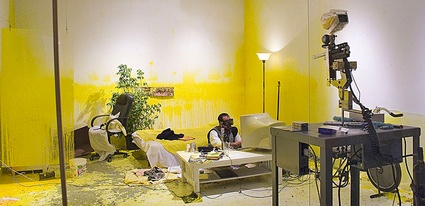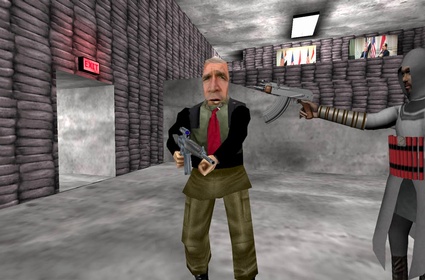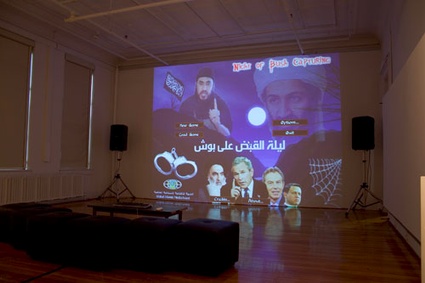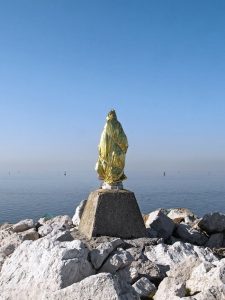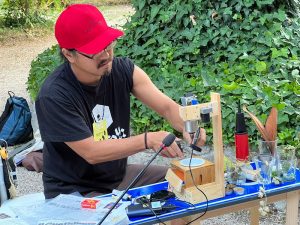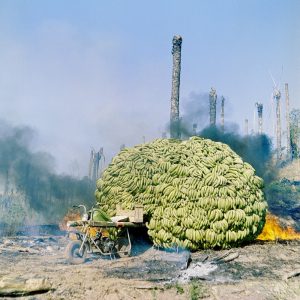Previous post on this panel: Positions in Flux – Panel 1: Art goes politics – Hans Bernhard from UBERMORGEN.COM
Geert Lovink, smart and fast as ever, has already blogged the whole panel, so make your way to his place for a shortcut and an alternative report on the discussion: Political Work in the Aftermath of the New Media Arts Crisis.
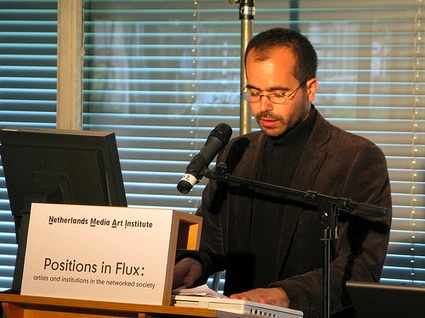 Image credit: NIMK
Image credit: NIMK
Art goes politics, the first panel of Positions in Flux, discussed how/whether media art has the potential to contribute to global and local problems such as religious and territorial conflicts, environmental or social crisis.
One of the three artists invited to participate to the discussion is Wafaa Bilal. Born in Iraq, Bilal gained worldwide fame in 2007 with his performance Domestic Tension (aka. Shoot an Iraqi) which enabled web users around the world to control a paintball gun and shoot at him 24 hours a day. For a whole month. His works are being exhibited and discussed internationally and he is currently Assistant Arts Professor at Tisch School of Arts, NYU.
The artist presentation was articulated around his artworks:
Domestic Tension
How can artists today make images mean something, stimulate people and provoke them? Problems that political art face: disengagement of the issue and tendency of some artists to express the issues at stake through aesthetic pain rather than aesthetic pleasure. Bilal grew up in an oppressed society and didn’t have the leisure to meditate on aesthetic alone. He therefore works with both aesthetic pain and aesthetic pleasure.
On May 4, 2007, Bilal set up his living and working quarters in a Chicago art gallery to perform Domestic Tension – Shoot an Iraqi. The project was a way for him to deal with the grief over the death of his brother in his hometown back in 2004. Bilal realized that he lives a comfortable life in the USA while his family is still in Iraq. Americans have been relatively shielded of the pain and suffering people experience in Iraq in their name. What kind of ethical consequence would seeing the consequences of war trigger? Would it humanize the issue? How can an artist go beyond a mere street protest (which alienates people most of the time anyway)?
Bilal found out that internet enables an artist to enter the safety zone of people’s house whether they like it or not. Domestic Tension ended up exposing more complex issues than the artist had imagined at first. It was also a bigger success than he had hoped for. By the end of the one month performance in the gallery, the Domestic Tension website had received 80 million hits. The results of the work were both healing and disturbing for him. Some took control of the paintball gun in a very aggressive way, hacking the system so that the gun would shoot non-stop but by day 21, Bilal noticed that the gun was going right and left, not aiming at him. It turned out that a group of 39 people had united force to prevent people from shooting at the artist. They called themselves ‘the virtual human shield.’
On day 14 of Domestic Tension, a link to the project was posted on Digg.com and Bilal was bombarded non stop, he couldn’t fill the paintball fast enough to keep up with the demand.
The themes Domestic Tension explored:
Conflict Zone vs. Comfort Zone
Aesthetic pleasure vs. Aesthetic pain
Virtual platform and physical platform
The body has its own language
The nature of the medium: interactive (the term is used the wrong way, most interactive work should be labeled responsive because the outcomes are predetermined) vs. dynamic (a platform in which all possible end-states are unknown.)
Domestic Tension embedded the horror in the experience and allowed webusers to participate. People invested their own narrative and integrated the one of the artist.
After Domestic Tension
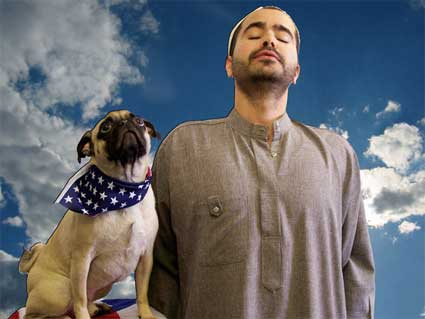
In 2008, while he was in residence at Rensselaer Polytechnic Institute, Wafaa created Dog or Iraqi, asking people to vote who — a dog named “Buddy,” or an Iraqi, himself — would be submitted to waterboarding, a form of torture that consists in immobilizing the victim and pouring water into the breathing passages to have them experience drowning. PETA obviously went mad about the idea that a dog would be harmed in the project, they were quite undisturbed by the fate of the Iraqi. Bilal lost to the dog and was submitted to waterboarding.
The next project was Night of Bush Capturing: Virtual Jihadi, a modified version of the first person shooter video game Quest for Bush, itself a “hacked” version of the commercial video game Quest for Saddam. In Bilal’s version the artist inserted his personal narrative by casting himself as a suicide bomber who gets sent on a mission to assassinate President George W. Bush. He was intrigued by the idea that a terrorist organization had released a free game to recruit people. Rensselaer Polytechnic Institute had to cancel the show after governmental pressures. At the time, the College Republicans called the RPI’s Arts department “a safe haven for terrorists” on their blog. A second exhibition of the project had to be shut down due to the fact that the gallery didn’t comply with some regulation about the size of its doors.
The objectives of the game were many:
– A mirror to expose hypocrisy and racism,
– Reverse the role of hunter and hunted,
– involve people who may not be willing to otherwise engage in a dialogue,
– Address the issue of suicide bombers.
For Bilal, new media art and interactivity presuppose the active involvement of a public whose function was once limited to viewing only. If the audience takes an interest in the work, they are more likely to engage in a dialogue that might, in the best cases, be revolutionary.
I would, once again, like to recommend Waffa Bilal’s book Shoot An Iraqi, Art, Life and Resistance Under the Gun to get to know more about his experience and art work. Previously: A few words with Wafaa Bilal and When interactive art becomes bored with you.

